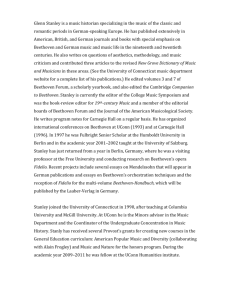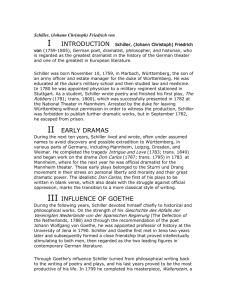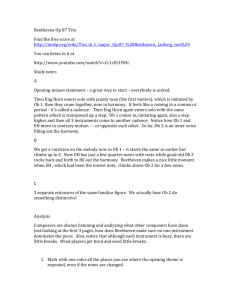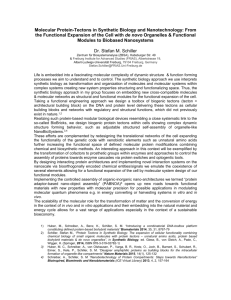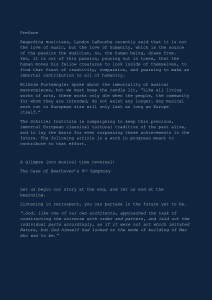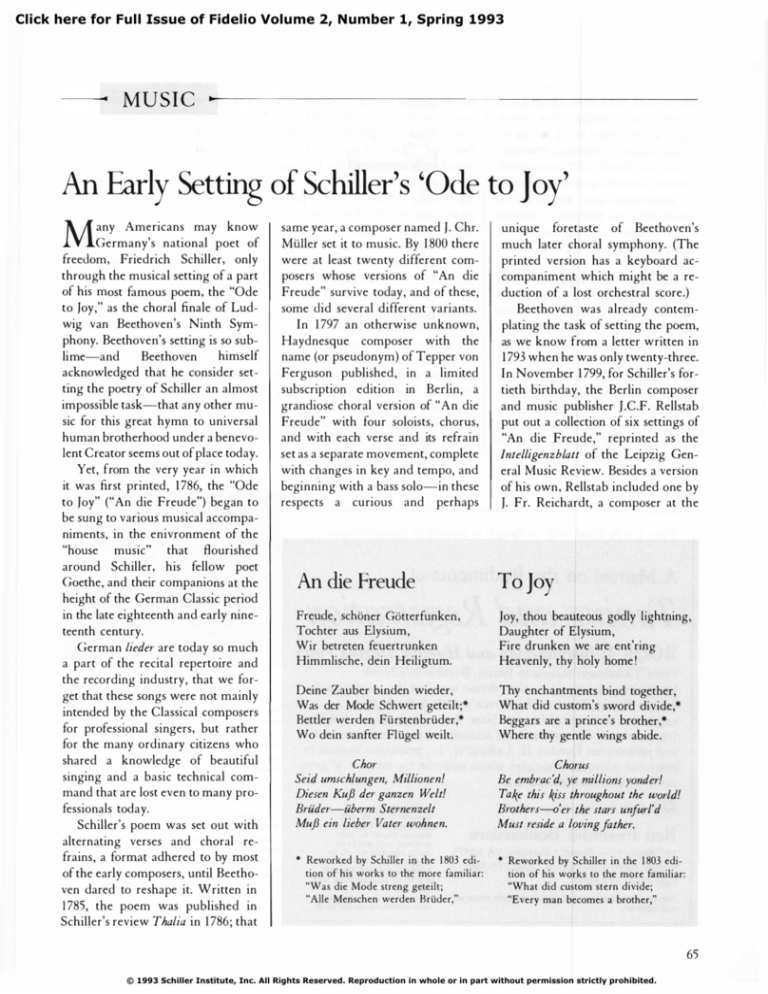
Click here for Full Issue of Fidelio Volume 2, Number 1, Spring 1993
-_
..
MUSIC
�
-------------------
An Early Setting of Schiller's 'Ode to Joy'
M
any Americans may know
Germany's national poet of
freedom , Friedrich Schiller , only
through the musical setting of a part
of his most famous poem , the "Ode
to Joy , " as the choral finale of Lud­
wig van Beethoven's Ninth Sym­
phony. Beethoven's setting is so sub­
himself
Beethoven
lime-and
acknowledged that he consider set­
ting the poetry of Schiller an almost
impossible task-that any other mu­
sic for this great hymn to universal
human brotherhood under a benevo­
lent Creator seems out of place today.
Yet , from the very year in which
it was first printed , 1 786, the "Ode
to Joy" ("An die Freude") began to
be sung to various musical accompa­
niments , in the enivronment of the
that flourished
"house musIC
around Schiller , his fellow poet
Goethe , and their companions at the
height of the German Classic period
in the late eighteenth and early nine­
teenth century.
German lieder are today so much
a part of the recital repertoire and
the recording industry , that we for­
get that these songs were not mainly
intended by the Classical composers
for professional singers , but rather
for the many ordinary citizens who
shared a knowledge of beautiful
singing and a basic technical com­
mand that are lost even to many pro­
fessionals today.
Schiller's poem was set out with
alternating verses and choral re­
frains , a format adhered to by most
of the early composers , until Beetho­
ven dared to reshape it. Written in
1 785, the poem was published in
Schiller's review Thalia in 1 786 ; that
same year , a composer named J . Chr.
Muller set it to music. By 1 800 there
were at least twenty different com­
posers whose versions of "An die
Freude" survive today , and of these ,
some did several different variants.
I n 1 797 an otherwise unknown ,
Haydnesque composer with the
name (or pseudonym) of Tepper von
Ferguson published , in a lim ited
subscription edition in Berlin , a
grandiose choral version of " A n die
Freude" with four soloists , chorus ,
and with each verse and its refrain
set as a separate movement , complete
with changes in key and tempo , and
beginning with a bass solo-in these
respects a curious and perhaps
unique foretaste of Beethoven's
much later choral symphony. (The
printed version has a keyboard ac­
companiment which might be a re­
duction of a lost orchestral score.)
Beethoven was already contem­
plating the task of setting the poem ,
as we k now from a letter written in
1 793 when he was only twenty-three.
I n November 1 799, for Schiller's for­
tieth birthday , the Berlin composer
and music publisher J .C.F. Rellstab
put out a collection of six settings of
"An die Freude , " reprinted as the
Intelligenzblatt of the Leipzig Gen­
eral Music Review. Besides a version
of his own , Rellstab included one by
J. Fr. Reichardt , a composer at the
An die Freude
To Jay
Freude , schaner Gotterfunken ,
Tochter aus Elysium ,
Wir betreten feuertrunken
Himmlische , dein Heiligtum.
Joy , thou beauteous godly lightning ,
Daughter of Elysium ,
Fire d runken we are ent'ring
Heavenly , thy holy home !
Deine Zauber binden wieder ,
Was der Mode Schwert geteilt;*
Bettler werden Furstenbruder , *
Wo dein sanfter Flugel weilt.
Thy enchantments bind together ,
What did custom's sword divide , '"
Beggars are a prince's brother , '"
Where thy gentle wings abide.
Char
Seid umschlungen, Millionen!
Diesen Kuj3 der ganzen Welt!
Briider-iiberm Sternenzelt
Muj3 ein lieber Vater wohnen.
Chorus
Be embrac'd, ye millions yonder!
Take this kiss throughout the world!
Brothers--o'er the stars unfurl'd
Must reside a loving father.
•
•
Reworked by Schiller in the 1 803 edi­
Reworked by Schiller in the 1 803 edi­
tion of his works to the more familiar:
tion of his works to the more familiar:
"AIle Menschen werden B r Uder,"
"Every man becomes a brother,"
"Was die Mode streng gete i l t ;
"What did custom stern divide;
65
© 1993 Schiller Institute, Inc. All Rights Reserved. Reproduction in whole or in part without permission strictly prohibited.
Berlin court who often antagonized
Goethe and Schiller, but whose
many songs setting Schiller's poems
greatly helped to popularize Schiller
in the first decade of the nineteenth
century. The collection also included
an anonymous tune which, before
Beethoven, was destined to become
the most famous setting, and contin­
ued to be sung throughout the last
century.
Indeed, in 1 805, when Beethoven
first produced his opera Fidelio, he
used the theme of the last line of that
popular version of "An die Freude"
as the basis for the choral finale,
when the chorus of prisoners and
townspeople unite to sing " Wer ein
holdes Weib errungen, stimm in un ­
serm Jubel ein " ("Who e'er a lovely
wife has won, chime in with our
j ubilation ! ") Any German listener of
that era would have recognized the
nearly identical words of the second
stanza of Schiller's ode, " Wer ein
holdes Weib errungen, mische seinen
Jubel einl" This chorus in Fidelio can
therefore be considered the first ma­
jor attempt by Beethoven to set "An
die Freude," which is highly appro­
priate, since the whole opera is a trib­
ute to Schiller's ideals.
The anonymous tune was so pop­
ular that it was published again in
Berlin in 1 800 in English ( ! ) as one
of "Twelve Favorite Songs." Unfor­
tunately, we were unable to inspect
this edition and cannot comment on
the quality of the translation.
Thi rty years after Beethoven first
mentioned his desire to compose the
"Ode to Joy," and nearly twenty
years after he began working on his
opera Fidelio in 1 803, there appears
in his sketches for the Ninth Sym­
phony, a line of music in the bass clef
with the words, "this it is, Ha now
it is found," followed by "Freude,
schoner," under the opening notes
of the choral theme. Beethoven had
finally found exactly the right line of
music to express the developmental
possibilities of Schiller's concept of
joy. Like the folk -tune which he had
earlier adapted for the great choral
finale of Fidelio, the melody is one of
the utmost "popular" simpl icity. By
using such simple material and
weaving it into higher and higher
orders of complexity spanning the
entire universe of human thought
and feeling, Beethoven unfolded the
message of human redemption
which is implicit throughout Schil­
ler's "Ode to Joy," and carries us,
together with the cherub at the cli­
max of the finale, until we "stand
before God ."
-Nora Hamerman
The book that will unleash a musical revolution-
A Manual on the Rudiments of
Tuning and Registration
BOOK I : Introduction and Human Singing Voice
F rom Tiananmen Square to Berl i n , Beethove n ' s Ni nth
Symphony was chosen as the "theme song" of the revolution for
human d ignity , because Beethoven ' s work is the highest
expression of Classical beauty . Now, for the first time, a Schiller
Institute team of musicians and scientists , headed by statesman
and philosopher Lyndon H. LaRouche, J r. , presents a manual to
teach the u niversal principles which underlie the creation of great
Ben Franklin Booksellers
1 07 South King Street, Leesbu rg, VA 22075
Phone : (800) 453-41 08 or (703) 777-366 1
Fax : (703) 777-8287
Visa and MasterCard accepted. Virginia residents please add
4.5% sales tax.
66
interpretation of music, particularly regarding the
tone production of singers and string players
alike . . . . I fully endorse this book and
congratulate Lyndon LaRouche on his
initiative. "
-Norbert Brainin, founder and first violinist,
Amadeus Quartet
works of Classical musical art.
$30 p l u s $4. 50 shipping and handling
"This Manual is a n indispensable contribution to
the true history of music and a guide to the
Foreign postage:
Canada: $7.00; for each
additional book add $1 .50
Mexico: $1 0.00; for each
additional book add $3.00
South America: $1 1 .75; for
each additional book add $5.00
Australia and New Zealand :
$1 2.00; for each additional book
add $4.00
Other countries: $1 0.50; for
each additional book add $4.50
" . . . without any doubt an excellent initiative. It
is particularly important to raise the question of
tuning in connection with bel canto technique,
since today's high tuning misplaces all register
shifts, and makes it very difficult for a singer to
have the sound float above the breath . . . . What
is true for the voice, is also true for instruments."
-Carlo Bergonzi
An die Freude
Anonymous Folk Song
Printed 1 8 0 1
Friedrich Schiller
\ Freu / Wir
I
I
� �##
� t3 F
I
�
1#
#
wo dein
F F"
schlun - gen,
j
wie
D P I
*
der,
F
Got - ter
feu - er
EJ
bin - den
## #
� 1##
scho - ner
ere - ten
F F F F I
brU -
I
de
be -
Zau - ber
zeit
mull
Ii
f
-
*
der
was
EJ tJ
ter
sanf -
- a
-
Jl
em
D
*
ken,
ken,
die
Ma - de
j
Flu - gel
weilt.
*
*
Iy - si Hei - lig -
dein
ge
-
teilt,
Becc - ler
urn - schlun - gen, Mil
Kull
[J
wah
-
der
J
gan
nen,
-
1VI:
we
-
zen _
�
Jl
Jl
*
�
mull
�
ein
urn,
cum.
•
Jl
Dei - ne
j) j) I J J F F
*
h J) I J J J.
Seid
1J
etn h Omes
Wer
streng
'---'
Va - ter
" 1VI:
E
aus_
sche_
h h I J. J5 n n I J
die - sen
:11 )
*
Tach - ter
Himm - Ii -
J J
nen!
lie - ber
F
P P I F F 'f f I ['
IF J F F
�
�
- fun - trun -
P I EJ F
-
Mil
Jl
*
Err
J F F I
�
wer - den
Jl
-
Ii
I go J
- 0
-
FUrs - ten -
) j) I
*
nen,
seid
um -
J. J I J J J J
Welt!
BrU - der
[J
IF J F F
lie - ber
Va - ter
t b errungen
-
U - berm
woh
-
Ster - nen -
J
II
*
nen.
"
Openingphrase of the chorus from Ludwig van Beethoven's "Fidelio"
Soprano
II
�
A�O
tJ
�
T nor
\'
Bass
Allegro
Wer
em
rna
non tropp o
hoi - des
Weib
er - run - gen,
stimm
r
m
I'
un - sern
Ju - bel
ein,
stimm in
un - sern Ju - bel
ein,
�m
ein,
!..
Wer ein
hoi - des Weib
I
Wer
em
hol - des
�.
Wer
em
Weib
er - run - gen,
I
er - run - gen,
stimm
in
un - sern
Ju - bel
ein,
sti
in
un- sern Ju - bel
stimm
m
un - sern
Ju - bel
ein,
stimm i n
un - sern Ju - bel
A
A
un - sern
Ju - bel
�
hoi - des
Weib
er - run - gen,
stimm
m
I'
ein,
•
I
ein,
stimm in
I'
un - sern Ju - bel
ein,
67


